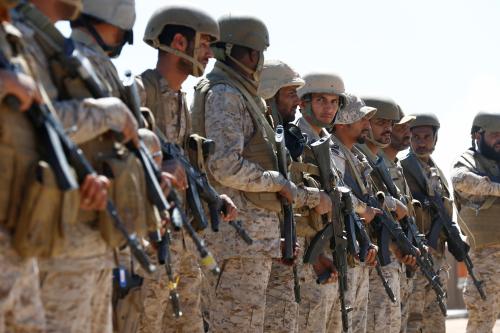Painful though it may be, the United States needs to begin the work of pulling back from its overwhelming involvements in the Middle East. This is the conclusion we draw in our new Foreign Affairs article, “America’s Middle East Purgatory: The Case for Doing Less.” At a time when U.S. interests in the Middle East are declining at pace with the American public’s appetite for commitments in the region, the United States must embrace a Middle East policy defined by greater clarity and discipline.
Both Barack Obama and Donald Trump have struggled to balance a preference for reducing America’s extensive regional commitments with the breakdown of regional order and the vociferous protestations of America’s regional partners. The push-pull dynamic between American and regional preferences has produced a worst-of-both-worlds approach to policymaking, by which American involvement remains at a level high enough to incur significant costs, but too low to drive the region toward a more positive trajectory.
The Saudi-backed war in Yemen illustrates this problem clearly. The Trump administration, like the Obama administration before it, supports the Saudi air campaign to dislodge Houthi rebels from the territories they captured after the outbreak of fighting in 2015. This has contributed to enormous civilian suffering, and produced no decisive victory—leading a majority of senators to vote to advance a resolution that would end American support for the campaign. Saudi Arabia and the United Arab Emirates argue that Yemen is a critical front against Iranian expansionism, and the Trump administration echoes this view. Yet Trump remains half-in and half-out: unwilling to use the leverage it has to push for an end to the fighting, but also unwilling to invest directly in its partners’ military objectives. As a result, Trump and the United States are deeply implicated in the horrific consequences of a war they did not choose and over which they have little control—and which distracts from the more serious issues of Iranian entrenchment across the Levant.
The past 15 years of extensive and inconclusive military commitments have soured many Americans, including in the policy world, on the United States trying to do big things in the Middle East through its own efforts. To avoid quagmires, policymakers often talk of working “by, with, and through” regional partners to achieve our ends at lowered costs. But success depends on regional partners working toward the same ends as we are. In the Middle East, as regional partners are fighting for regional dominance—and the salience of the region to Washington’s interests declines—this is increasingly unlikely to be the case. As U.S. leaders continue to shift needed resources to address power competitions with Russia and China, they need to have a more clear-eyed view of their Middle Eastern partners’ interests, flaws, capabilities, and limitations.
While the United States does share Saudi Arabia’s interest in countering the spread of Iranian influence in the region, the two diverge widely on how and where to pursue this end. American support for the war in Yemen was not the product of a U.S. strategic imperative or a shared vision for how to roll back Iran, but instead quiet compensation to the Saudis for the Iranian nuclear agreement.
Lessened American engagement in the Middle East will carry risks, and the region will likely continue to suffer a range of ugly outcomes. But it has become clear that the United States cannot realistically attempt to address the fundamental challenges of the region without enormous investments—which it has so far been unwilling to make, and which might not even succeed. We know what doing more in the Middle East looks like—and it’s ugly. Doing less might look ugly, too—but given the increasing opportunity costs for Washington of prioritizing the Middle East, it is time to give it a try.
The Brookings Institution is committed to quality, independence, and impact.
We are supported by a diverse array of funders. In line with our values and policies, each Brookings publication represents the sole views of its author(s).










Commentary
Getting America out of Middle East purgatory
December 11, 2018